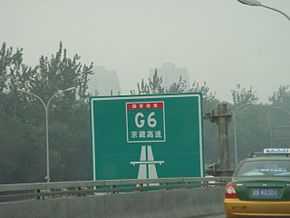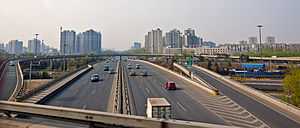
Beijing–Lhasa Expressway |
|---|
|
北京-拉萨高速公路
|
Jingzang Expressway
京藏高速公路 |
|

The current Beijing–Lhasa Expressway is highlighted in red. The portion between Xining and Lhasa, highlighted in purple, is still in planning and not constructed. |
|

G6 signage leaving Beijing |
| Route information |
|---|
Part of   |
| Length: |
3,710 km[1] (2,310 mi)
Length when complete. |
|---|
| Major junctions |
|---|
| East end: |
Madian Bridge, North 3rd Ring Road, Beijing |
|---|
| West end: |
Lhasa, Tibet Autonomous Region (when complete)
Chaidamu Road, Xining, Qinghai (current) |
|---|
| Highway system |
|---|
|
Expressways
|
The Beijing-Tibet Expressway (Chinese: 北京-西藏高速公路; pinyin: Běijīng-Xīzàng gāosù gōnglù), commonly abbreviated to Jingzang Expressway (Chinese: 京藏高速), also known as Beijing-Lhasa Expressway (Jingla Expressway; Chinese: 京拉高速公路) or China National Expressway 6, is part of the Chinese national expressway network and is planned to connect the nation's capital, Beijing, to the capital of the Tibet Autonomous Region, Lhasa.
It passes through a total of seven China's administrative regions, including the Beijing municipality, the province of Hebei, the autonomous regions of Inner Mongolia and Ningxia, the provinces of Gansu and Qinghai, and finally the Tibet Autonomous Region.
Passage

G6 Expressway at the interchange with the Fifth Ring Road in northern Beijing.
Beginning from Beijing and driving southwest to Lhasa, The expressway runs approximately 3,710 kilometres (2,310 miles) through Hebei, Inner Mongolia, Ningxia, Gansu and Qinghai, for a total of seven provincial-level divisions. Excluding the two terminal points, it passes through the major cities of Zhangjiakou, Jining District, Hohhot, Bayan Nur, Wuhai, Yinchuan, Wuzhong, Baiyin, Lanzhou, Xining and Golmud.
As of August 2010, just over fifty percent of the expressway is open to traffic, which mainly comprises the stretch between Beijing and Xining. Like China National Highway 109 and the Qingzang railway, it is expected to pass west through Golmud before heading southwest into Tibet and Lhasa. Because of climatic conditions, this stretch of the expressway does not yet have a construction timetable.[2]
The G6 merges with the G7 in Hebei and does not split until around a third of the way through Inner Mongolia.
Interchanges
 From Beijing From Beijing  |
|---|
|
 Towards Beijing Towards Beijing  |
See also
References
|
|---|
| | | | Primary | |
|---|
| | Branch | |
|---|
| | Auxiliary |
- G0111
- G0211
- G0511 (Sichuan)
- G0511 (Shaanxi)
- G0512
- G0611
- G0612
- G0613
- G0615
- G0711
|
|---|
| North-South Expressways | | | Primary | |
|---|
| | Branch |
- G15W
- G15W2
- G15W3
- G65E
- G65W
|
|---|
| | Auxiliary | |
|---|
| East-West Expressways | | | Primary | |
|---|
| | Branch | |
|---|
| | Auxiliary | |
|---|
| Regional Ring Expressways | | | Primary | |
|---|
| | Branch | |
|---|
| | Auxiliary | |
|---|
| City Ring Expressways | | | Ring |
- G0102
- G0401
- G0501
- G0601 (Hohhot)
- G0601 (Lhasa)
- G0601 (Xining)
- G1001
- G1101
- G1501 (Fuzhou)
- G1501 (Guangzhou)
- G1501 (Haikou)
- G1501 (Ningbo)
- G1501 (Qingdao)
- G1501 (Shanghai)
- G1501 (Shenyang)
- G1501 (Xiamen)
- G1502
- G2001 (Jinan)
- G2001 (Shijiazhuang)
- G2001 (Taiyuan)
- G2001 (Yinchuan)
- G2002 (Yangquan)
- G2201 (Lanzhou)
- G2501 (Hangzhou)
- G2501 (Nanjing)
- G2501 (Shenzhen)
- G2501 (Tianjin)
- G3001 (Lanzhou)
- G3001 (Ürümqi)
- G3001 (Xi'an)
- G3001 (Zhengzhou)
- G4001
- G4201 (Chengdu)
- G4201 (Wuhan)
- G4202
- G4501
- G5001
- G5601
- G6001 (Guiyang)
- G6001 (Nanchang)
- G7201
- Unclear status as national or provincial expressways, including but not limited to:
- G1201 Songyuan
- G5501 Datong
- S3 Cangzhou
- G2201 Handan
- G2201 Changzhi
- G3/G30/G2513 Xuzhou
- G0601 Yinchuan
- S7501 Yuncheng
- S8311 Nanyang
- S9/S58 Suzhou
- S6501 Guilin
- S10 Wenzhou
- S4503 Ganzhou
- G4201 Nanchong
|
|---|
|
|
|---|
| Projected roads shown in italics | | | Ring roads | | |
|---|
| Chang'an Avenue
(list of sections) | |
|---|
| Ping'an Avenue
(list of sections) |
- Linglong Road
- Chegongzhuang West Road
- Chegongzhuang Street
- Ping'anli West Street
- Di'anmen West Street
- Di'anmen East Street
- Zhangzizhong Road
- Dongsi Shi Tiao
- Gongren Stadium North Road
- Agricultural Museum South Road
- Chaoyang Park South Road
- Yaojiayuan Road
- Shigezhuang Road (Side) / 2nd Airport Expressway (Main)
|
|---|
| Guang'an Avenue
(list of sections) |
- Guang'an Road (Side) / G4 Beijing - Hong Kong/Macau Expressway (Main)
- Guang'anmen Outer Street
- Guang'anmen Inner Street
- Luomashi Street
- Zhushikou West Street
- Zhushikou East Street
- Guangqumen Inner Street
- Guangqumen Outer Street
- Guangqu Road
|
|---|
| Central Axis
(list of sections) |
- Beichen Road
- Gulou Outer Street
- Old Gulou Street
- Di'anmen Outer Street
- Di'anmen Inner Street
- (Spilt into west and east part near Jingshan, Palace Museum and Tian'anmen Square)
- Qianmen Street
- Tianqiao South Street
- Yongdingmen Inner Street
- Yongdingmen Outer Street
- Nanyuan Road
- (Nanyuan Airport to be demolished)
- Nanzhongzhou Road (Provincial Highway S228)
|
|---|
| Qiansanmen Avenue
(list of sections) |
- Lianshi West Road
- Lianshi East Road
- Lianhuachi West Road
- Lianhuachi East Road
- Xuanwumen West Street
- Xuanwumen East Street
- Qianmen West Street
- Qianmen East Street
- Chongwenmen West Street
- Chongwenmen East Street
- Tonghui River North Road (Side) / Tonghui River North Express (Main)
|
|---|
| Xuanwumen Avenue
(list of sections) |
- Zhixin East Road
- Huayuan East Road
- Beitaipingzhuang Road
- Xinjiekou Outer Street
- Xinjiekou North Street
- Xinjiekou South Street
- Xisi North Street
- Xisi South Street
- Xidan North Street
- Xuanwumen Inner Street
- Xuanwumen Outer Street
- Caishikou Street
- Kaiyang Road
- Majiabao West Road
- Huaifang West Raod
|
|---|
| Chongwenmen Avenue
(list of sections) |
- Beiyuan Road
- Huixin West Street
- Yinghuayuan West Street
- Hepingli West Street
- Yonghegong Street
- Dongsi North Street
- Dongsi South Street
- Dongdan North Street
- Chongwenmen Inner Street
- Chongwenmen Outer Street
- Tiantan East Road
- Puhuangyu Road
- Liuxiang Road
- Dexian Road
- G3 Third Beijing-Tianjin Corridor
|
|---|
| | Other |
- Fengti South Road - Lize Road
- G109 - Fushi Road - Fucheng Road - Fuchengmen Outer Street - Fuchengmen Inner Street
- Chaoyangmen Inner Street - Chaoyangmen Outer Street - Chaoyang Road - Tongzhou - Yanjiao Expressway
- Xishiku Street - Deshengmen Inner Street - Deshengmen Outer Street - G6
- Andingmen Inner Street - Andingmen Outer Street - Anding Road - Anli Road - Litang Road
- Caihuying South Road - G45 (To Kaifeng/Guangzhou)
- Xizhimen Outher Road - Xueyuan Road - Xueqing Road
- Zizhuyuan Road - Xingshikou Road
- Wanquanhe Road - Yongfeng Road
|
|---|
| | Expressways | |
|---|
| | National Highways | |
|---|
|




